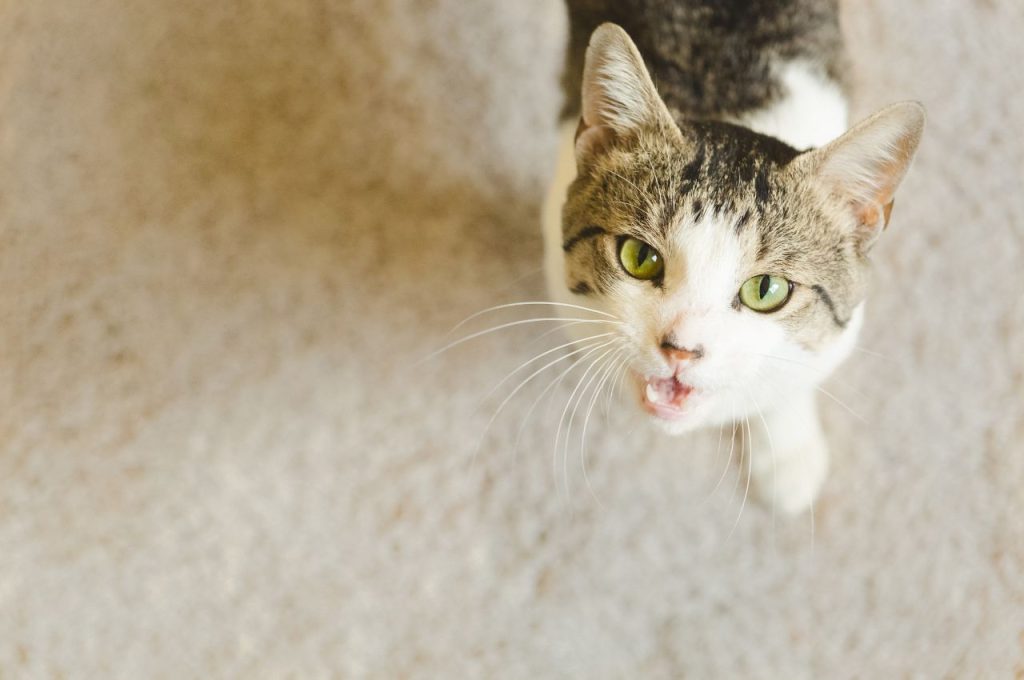To teach your cat to talk, use positive reinforcement techniques and consistent repetition of verbal commands. Teaching a cat to talk can be a fun and rewarding experience.
While it is common knowledge that cats cannot technically speak like humans, they can be taught to vocalize certain sounds on command. By using positive reinforcement techniques and consistent repetition of verbal commands, you can encourage your cat to communicate with you in its unique way.
This can involve using treats, praise, and rewards to reinforce desired vocalizations. With patience and persistence, you can establish a form of communication with your feline friend that goes beyond mere meows and purrs. We will explore some techniques and tips to help you teach your cat to talk.
Understanding Cat Communication
Teaching your cat to communicate can be an interesting and rewarding experience. Discover effective ways to understand and encourage your furry friend to “talk” and express their needs, strengthening the bond between you.

Understanding Cat Communication When it comes to teaching your cat to talk, a crucial aspect is understanding how cats communicate. Cats have their own unique set of vocalizations and body language that they use to express themselves. By familiarizing yourself with these forms of communication, you can better navigate the process of teaching your cat to talk.
Importance of Cat Communication
Cat communication is essential for building a strong bond with your furry friend. By grasping the significance of cat communication, you can gain a deeper understanding of your cat’s needs and emotions. Cats use a variety of vocalizations, such as meowing, purring, hissing, and growling, to convey their feelings. Additionally, they rely on body language cues like tail position, ear position, and facial expressions to express themselves. By paying attention to these signs, you can respond appropriately to your cat’s needs and establish a better connection.
Types of Cat Communication
Cats express themselves through various forms of communication. Understanding the different types of cat communication can greatly assist you in teaching your cat to talk. Here are some common methods of cat communication:
- Verbal vocalization: Meowing is perhaps the most recognized form of vocalization in cats. It can signify a range of emotions, including hunger, loneliness, or simply a desire for attention. Purring, on the other hand, usually indicates contentment or relaxation.
- Body language: Cats use their bodies to communicate a wide array of emotions. For example, an upright tail usually indicates a happy and confident cat, while a puffed-up tail can signify fear or aggression. Similarly, flattened ears often indicate fear or aggression, while relaxed ears represent a calm and content cat.
- Grooming: Grooming is not only a way for cats to keep themselves clean but also a means of communication. Mutual grooming, known as allogrooming, strengthens the bond between cats and displays trust and affection.
- Scent marking: Cats have scent glands throughout their bodies, and they use scent marking to communicate with other cats. This can include rubbing against furniture or people, scratching objects, or even urine marking in some cases.
Understanding these various forms of communication will allow you to decode your cat’s needs and desires more accurately, enabling you to effectively teach your cat to talk.
Obstacles in Teaching Cats to Talk
While it is possible to train cats to communicate with us in unique ways, there are several obstacles to keep in mind. Cats are known for their independent nature, and some may be less interested in learning verbal cues or mimicry. Additionally, each cat has its own personality and learning pace, so it’s important to be patient and understanding throughout the training process. Moreover, certain breeds may be more inclined to vocalize and communicate, while others may be more reserved. By recognizing these obstacles, you can adjust your expectations and tailor your training methods accordingly to achieve the best results with your feline companion. In conclusion, understanding cat communication is key to teaching your cat to talk. By recognizing the importance of communication, familiarizing yourself with the various types of communication, and being aware of possible obstacles, you can embark on a successful journey to teach your cat to talk and strengthen the bond between you and your feline friend.
Techniques to Teach Your Cat to Talk
Teaching your cat to talk can be an exciting and rewarding experience for both you and your furry friend. While cats may not be able to speak in the same way humans do, they are highly intelligent animals capable of understanding and responding to vocal cues. In this article, we will explore various techniques that you can use to teach your cat to communicate using their unique vocalizations. By following these tips, you will be able to strengthen the bond with your cat and enhance your communication in a fun and innovative way.

Building Trust and Bonding
Establishing trust and building a strong bond with your cat is crucial before embarking on any training endeavor. Cats are naturally independent creatures, and it is important for them to feel secure and comfortable in their environment. Here are some tips to help build trust:
- Create a Safe Space: Provide your cat with a designated area where they can retreat and feel safe. Fill this space with their favorite toys, blankets, and scratching posts.
- Positive Reinforcement: Reward your cat with treats and praise when they exhibit desired behaviors, such as coming when called or attempting to vocalize.
Using Clicker Training
Clicker training can be a highly effective method to train your cat to talk. This technique involves associating a distinct clicking sound with desired behaviors, which reinforces their understanding of vocal cues. Here’s how you can use clicker training to encourage vocalization:
- Introduce the Clicker: Begin by introducing the clicker to your cat. Click the device and immediately reward your cat with a treat. Repeat this process several times until your cat associates the clicking sound with a positive reward.
- Associate the Clicker with Vocal Behaviors: Once your cat is familiar with the clicker, use it to capture and reinforce vocalizations. Click the device when your cat makes any attempt to vocalize and reward them with a treat. Gradually increase the criteria for reward to encourage specific vocalizations.
Teaching Specific Vocal Commands
In addition to general vocalization, you can train your cat to respond to specific vocal commands. By consistently associating certain sounds with desired actions, you can create a unique language between you and your cat. Here are some steps to teach specific vocal commands:
- Choose Simple Words: Select short, distinct words or sounds that you can consistently use for specific commands. For example, you can use the word “come” to call your cat over to you.
- Use Repetition and Reinforcement: Repeat the chosen word or sound before your cat engages in the desired behavior, such as coming to you. Immediately reward your cat with treats or affection to reinforce the association between the vocal command and the action.
By employing these techniques, your cat will gradually learn to associate vocal cues with specific actions and behaviors. Remember to be patient, use positive reinforcement, and tailor the training to your cat’s personality and preferences. The key is to make the training sessions enjoyable and rewarding for both you and your feline companion. So, get started today and unlock a whole new level of communication with your talkative cat!
Troubleshooting and Tips
When teaching your cat to talk, it’s important to remember that not every cat will be able to mimic human speech exactly. However, with a little patience and consistency, you can still train your cat to communicate with you uniquely. In this section, we will explore some troubleshooting tips to help you overcome any challenges you may encounter during the training process.
Patience and Consistency
One of the key factors in teaching your cat to talk is patience. Just like any other training, it takes time for your cat to understand and learn what you’re trying to teach them. Don’t get discouraged if progress is slow at first, as each cat learns at their own pace. Be consistent in your training sessions, setting aside dedicated time each day to work with your cat.
During your training sessions, use a calm and encouraging tone to communicate with your cat. Start by introducing simple cues, such as associating a specific word or sound with a particular action or object. For example, consistently saying “treat” while offering a treat can help your cat associate the word with the reward. Repeat these cues regularly, reinforcing the connection between the word and the action or object.
Reward-based Training
One effective method to teach your cat to talk is through reward-based training. Cats respond well to positive reinforcement, so use treats or praise as a reward when your cat makes an effort to mimic sounds or vocalize. Whenever your cat makes a noise that resembles human speech, provide immediate positive reinforcement to encourage them to continue.
It’s important to note that not all cats will be able to mimic speech perfectly. Instead, focus on rewarding any vocalization attempts, whether they come in the form of meows, chirps, or other unique sounds. By associating their attempts with positive rewards, you can reinforce their communication skills and encourage them to vocalize more often.
Professional Consultation
If you’re facing challenges in teaching your cat to talk, don’t hesitate to seek professional consultation. A veterinarian or animal behaviorist can provide valuable insights and guidance tailored to your cat’s specific needs. They can help you understand any limitations your cat may have and provide effective strategies to overcome obstacles.

A professional can also evaluate any potential underlying health issues that could be affecting your cat’s ability to vocalize. Sometimes, certain medical conditions may hinder a cat’s vocal abilities, and addressing these health concerns can help improve their communication skills.
Remember, teaching your cat to talk is a unique journey that requires patience and consistency. By using reward-based training methods and seeking professional consultation when necessary, you can create a stronger bond with your feline companion and enhance your ability to communicate with each other.
Frequently Asked Questions For How Do You Teach Your Cat To Talk
How can I encourage my cat to talk?
To encourage your cat to talk, spend quality time with them and talk to them regularly affectionately, and playfully. Use a soft, high-pitched voice and mimic their vocalizations. Offer treats or rewards for any attempts they make at meowing or communicating.
Be patient and consistent in your efforts.
What are the buttons to teach cats to talk?
To teach a cat to “talk,” you can use buttons that produce different sounds or words when pressed by the cat. These buttons can be associated with specific actions or requests, helping the cat communicate its needs or desires.
Can you teach cats voice commands?
Yes, cats can be trained to respond to voice commands. Start with simple commands like “sit” or “come” and use treats as rewards. Consistency and patience are key to successful training.
Conclusion
Teaching your cat to talk may seem like a daunting task, but with consistent effort and patience, it is indeed possible. By using positive reinforcement techniques, such as clicker training and rewarding your cat’s vocal efforts, you can encourage them to communicate in their unique way.
Remember to pay attention to their body language and cues, as it can be just as essential as verbal communication. As you embark on this journey with your feline friend, remember that forming a strong bond and understanding their personality is the key to success.
Happy teaching!
